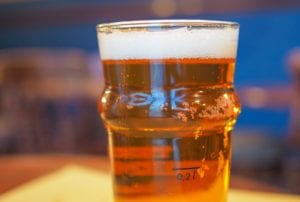Written by Taylor Woosley, Staff Writer. Findings of a longitudinal study show that risk factors for erosive esophagitis development for men was daily drinking and alcohol consumption of ≥70 g/week, compared to alcohol consumption of ≥140 g/week as a risk factor for women.
 Gastroesophageal reflux disease (GERD) is a common digestive disorder, with an estimated prevalence of 18.1-27.8% in North America1. The American College of Gastroenterology guidelines defines GERD as “symptoms or complications resulting from the reflux of gastric contents into the esophagus or beyond”2. Erosive esophagitis (EE) is one phenotypic presentation of GERD and refers to tissue changes in the esophageal mucosa in upper endoscopy3.
Gastroesophageal reflux disease (GERD) is a common digestive disorder, with an estimated prevalence of 18.1-27.8% in North America1. The American College of Gastroenterology guidelines defines GERD as “symptoms or complications resulting from the reflux of gastric contents into the esophagus or beyond”2. Erosive esophagitis (EE) is one phenotypic presentation of GERD and refers to tissue changes in the esophageal mucosa in upper endoscopy3.
Many factors may contribute to the development of EE and among them, there are non-modifiable factors such as age and sex, and modifiable factors, including lifestyle and excessive body weight4. Lifestyle factors such as smoking, alcohol consumption, sedentary activities, and poor diet are associated with GERD and EE5. Previous research has explicated that chronic alcohol consumption tends to be associated with an increased risk of EE, promoting acid regurgitation by reducing the pressure of the lower esophageal sphincter and slowing both esophageal motility and gastric emptying6.
Sogabe et al. conducted an observational longitudinal study to analyze the association between changes in alcohol consumption and EE development in both sexes. 2582 participants were included in the study who underwent regular health check-ups, including laboratory examinations and esophagogastroduodenoscopy. Information regarding smoking status, alcohol intake, exercise, diet, drug history and history of present illness were obtained using a self-report questionnaire. Average weekly alcohol consumption was classified into five categories: none, 0.1-69.9, 70-139.9, 140-279.9, and ≥280 g/week. Drinking frequency was classified into three categories: non-drinking, occasional drinking (1-6 days/week), and daily drinking.
Blood samples were obtained from all subjects after a 12 h fast to measure serum levels of aspartate aminotransferase, alanine aminotransferase, gamma-glutamyl transpeptidase, total cholesterol, high-density lipoprotein cholesterol (HDL-C), triglycerides (TGs), low-density lipoprotein cholesterol, uric acid, fasting plasma glucose (FPG), hemoglobin A1c, and high-sensitivity C-reactive protein. The X2 test and m x n X2 test were used to compare categorical variables between two groups and more than two groups. As the continuous data were not normally distributed, the Mann-Whitney U and Kruskal Wallis nonparametric tests were utilized to compare two groups and more than two groups, respectively.
Among men, of 1044 drinkers at baseline, 101 (9.7%) abstained from drinking, whereas 163 (14.7%) increased and 252 (24.1%) decreased their weekly drinking quantity across drinking categories. Among women, of 460 drinkers at baseline, 82 (7.3%) abstained from drinking, whereas 59 (12.8%) increased and 142 (39.0%) decreased their weekly drinking quantity across drinking categories. Significant findings of the longitudinal study are as follows:
- Among men, 211 (15.0%) of 1405 subjects without EE at baseline developed EE at follow-up. Among women, 79 (6.7%) of 1177 participants without EE at baseline developed EE at follow-up. The prevalence of EE development was not significantly different across male age groups but was significantly different across female age groups (p<0.05).
- After adjusting for age, BMI, WC, lifestyle habits, hypertension, dyslipidemia, IGT, and H. pylori, the OR for EE development in male drinkers was 1.252 (95% CI, 0.907–1.726, p = 0.171). For men aged <50 years, drinking ≥70 g/week was a significant risk factor for EE development (OR = 2.825, 95% CI, 1.428–5.542, p < 0.005).
- Among women, after adjusting for age, BMI, WC, lifestyle habits, hypertension, dyslipidemia, IGT, and H. pylori, the OR for EE development in drinkers was 1.078 (95% CI, 0.666–1.747, p = 0.760). Drinking ≥140 g/week was a significant risk factor for EE development among women (OR = 3.248, 95% CI, 1.646–6.410, p < 0.005).
Results of the study suggest that daily drinking and alcohol consumption of ≥70 g/week for men and ≥140 g/week for women were risk factors for EE development. Furthermore, drinking status by age was an important consideration for the prevention of EE. Study limitations include the possibility of selection bias resulting in lack of representation of the general population and not assessing the genotype of aldehyde dehydrogenase 2 which is associated with alcohol metabolism.
Source: Sogabe, Masahiro, Toshiya Okahisa, Miwako Kagawa, Hiroyuki Ueda, Kaizo Kagemoto, Hironori Tanaka, Yoshifumi Kida et al. “Influence of Alcohol Consumption on the Development of Erosive Esophagitis in Both Sexes: A Longitudinal Study.” Nutrients 14, no. 22 (2022): 4760.
© 2022 by the authors. Licensee MDPI, Basel, Switzerland. This article is an open access article distributed under the terms and conditions of the Creative Commons Attribution (CC BY) license (https://creativecommons.org/licenses/by/4.0/).
Click here to read the full text study.
Posted January 17, 2023.
Taylor Woosley studied biology at Purdue University before becoming a 2016 graduate of Columbia College Chicago with a major in Writing. She currently resides in Glen Ellyn, IL.
References:
- Clarrett DM, Hachem C. Gastroesophageal Reflux Disease (GERD). Mo Med. May-Jun 2018;115(3):214-218.
- Sandhu DS, Fass R. Current Trends in the Management of Gastroesophageal Reflux Disease. Gut Liver. Jan 15 2018;12(1):7-16. doi:10.5009/gnl16615
- Asreah RH, Abdullhameed A. Risk factors of erosive esophagitis and barrett’s esophagus in patients with reflux symptoms. Med J Islam Repub Iran. 2021;35:75. doi:10.47176/mjiri.35.75
- Taraszewska A. Risk factors for gastroesophageal reflux disease symptoms related to lifestyle and diet. Rocz Panstw Zakl Hig. 2021;72(1):21-28. doi:10.32394/rpzh.2021.0145
- Zhang M, Hou ZK, Huang ZB, Chen XL, Liu FB. Dietary and Lifestyle Factors Related to Gastroesophageal Reflux Disease: A Systematic Review. Therapeutics and clinical risk management. 2021;17:305-323. doi:10.2147/tcrm.S296680
- Wang F, Li G, Ning J, et al. Alcohol accumulation promotes esophagitis via pyroptosis activation. Int J Biol Sci. 2018;14(10):1245-1255. doi:10.7150/ijbs.24347
